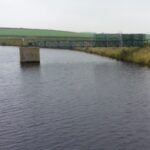A discovery beneath a Scottish high school has turned back the clock on Scotland’s ancient past — revealing Neolithic timber halls that predate even the mighty Stonehenge.
Carnoustie’s Hidden Past Comes to Light
Archaeologists digging under Carnoustie High School in Angus stumbled upon something no one expected. Tucked away beneath school grounds were the remains of what experts now say is the largest early Neolithic timber hall ever found in Scotland.
One line.
This hall, believed to date back to around 4,000 BC, is older than Stonehenge — pushing back the timeline for Scotland’s first farming communities by centuries. Guard Archaeology, the team leading the excavation, says the find is rewriting what we know about how these early people lived, gathered, and shaped their landscape.

A Peek Inside Scotland’s First Settlers
So what did these Neolithic halls look like?
They weren’t exactly humble huts. This particular hall measures an impressive 35 metres long and 9 metres wide — built using sturdy oak timbers. The roof? Massive posts spaced just right to hold everything up.
Archaeologists believe these spaces weren’t just places to sleep. They likely played host to ceremonies, feasts, and meetings — the heartbeat of an early farming community trying to tame a wild land.
One-liner here.
And they weren’t alone. This site suggests that similar halls dotted the region, giving ancient Scots a place to gather, talk, and maybe settle disputes.
Treasures from the Past
The excavation has turned up more than old timber posts.
Among the finds are objects that have historians buzzing:
-
A gold-decorated Celtic spearhead, shining like it was made yesterday.
-
A sword that hints at the ceremonial or defensive role these people might’ve held.
-
An incredibly well-preserved Bronze Age scabbard made of wood and leather.
One line.
Each of these items adds another puzzle piece to the story of Scotland’s first farmers. They were more than just subsistence farmers — they had complex social lives, rituals, and a sense of style that carried forward into later Celtic cultures.
Bigger Than Stonehenge? Not in Size — But in Age
Stonehenge gets all the headlines. But here’s the thing: these timber halls were built hundreds of years earlier.
Lydia Amazouz, who has been reporting on the dig, says this could reshape how we look at Neolithic Britain altogether.
It’s a reminder that while Stonehenge’s stones have survived, earlier wooden monuments laid the groundwork for what came next.
One line.
And yes, the timber rotted away long ago — but the postholes and artefacts remain to whisper secrets across five millennia.
School Kids on Top of History
Imagine having gym class on top of an ancient settlement.
That’s reality for pupils at Carnoustie High School, who’ve spent months peering through fences as archaeologists uncovered their school’s hidden past. For some, it’s sparked a new fascination with Scotland’s ancient history.
Experts believe there’s even more to find. It’s possible this hall was just one piece of a bigger settlement stretching beneath nearby playing fields.
Why This Matters
Finds like this don’t just make headlines — they shift how historians interpret Scotland’s earliest communities.
A table from GUARD Archaeology highlights what sets Carnoustie apart:
| Site | Estimated Age (BC) | Structure Type | Notable Finds |
|---|---|---|---|
| Carnoustie High Hall | ~4000 BC | Timber ceremonial hall | Gold spearhead, sword, Bronze scabbard |
| Stonehenge | ~2500 BC | Stone circle | Stone monoliths, burial mounds |
One line.
Suddenly, the idea that Scotland was a backwater before Stonehenge looks flimsy. Early Scots were already clearing forests, farming, and building big, communal spaces before Salisbury Plain saw its first standing stone.
The Next Dig Could Be Even Bigger
For now, the site is being carefully recorded before it disappears again beneath school grounds. Some pieces will go to local museums for everyone to see.
But experts say this is just the beginning. There’s hope for further excavations in Angus and beyond, with the chance to unearth more timber halls — and maybe even settlements to match.
One sentence here.
The echoes of ancient footsteps might be all that’s left, but they speak volumes about the lives of the people who walked Scotland’s fields long before the stones of Stonehenge rose from the chalk.


















